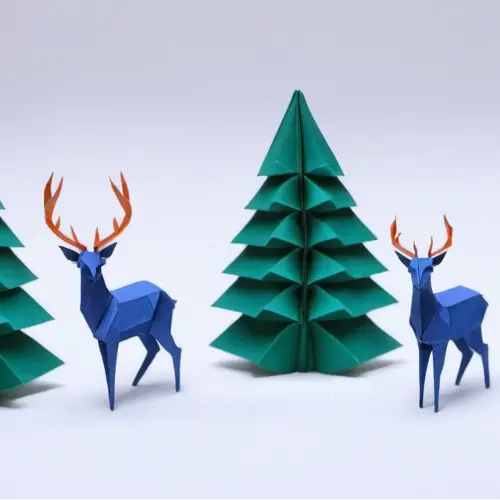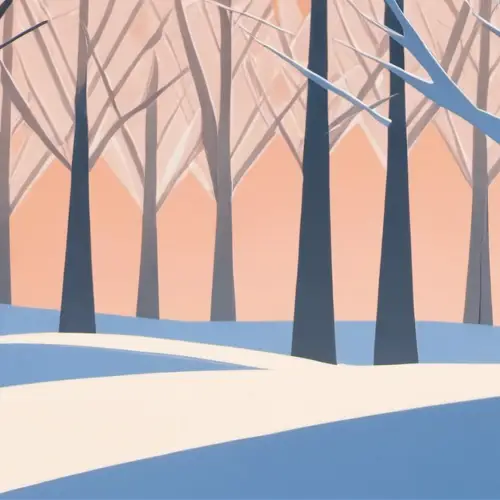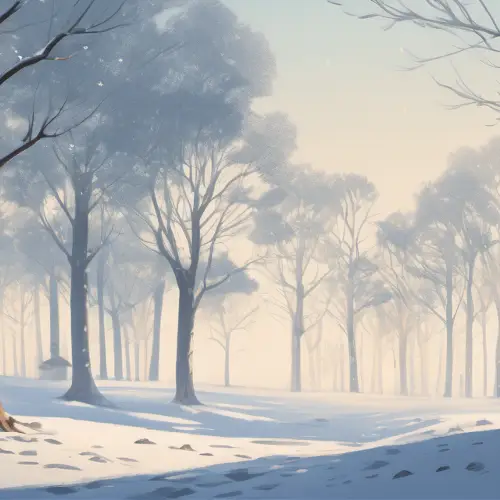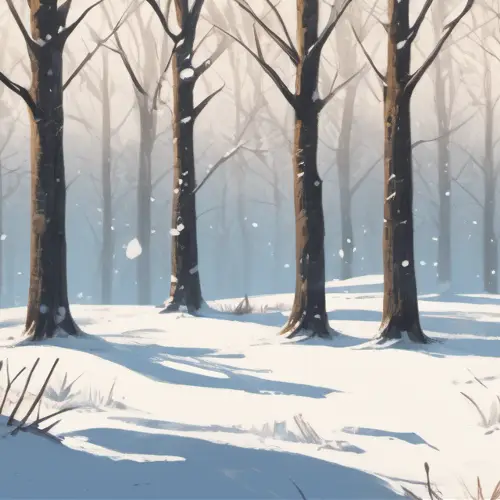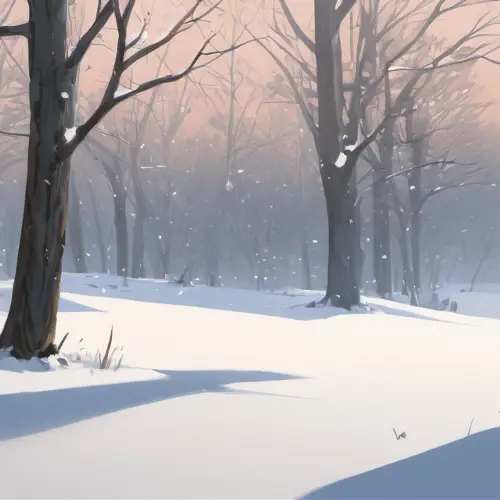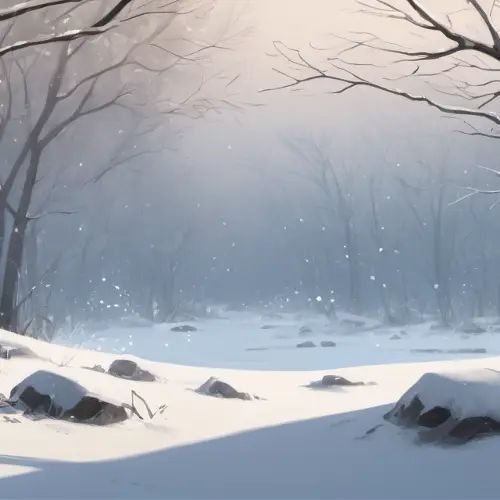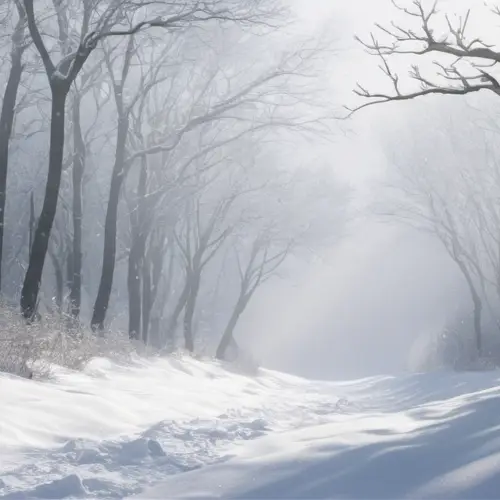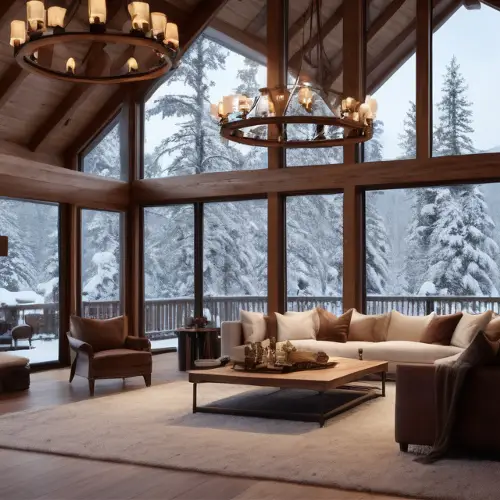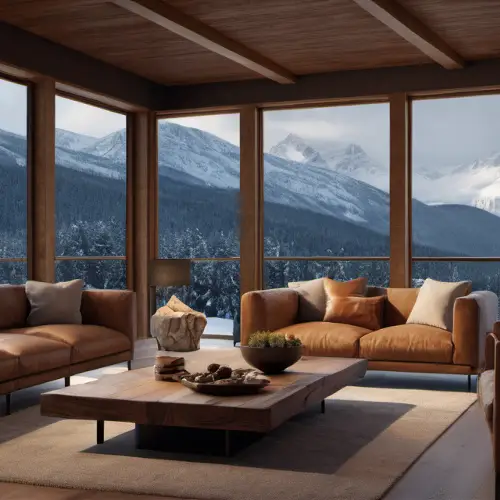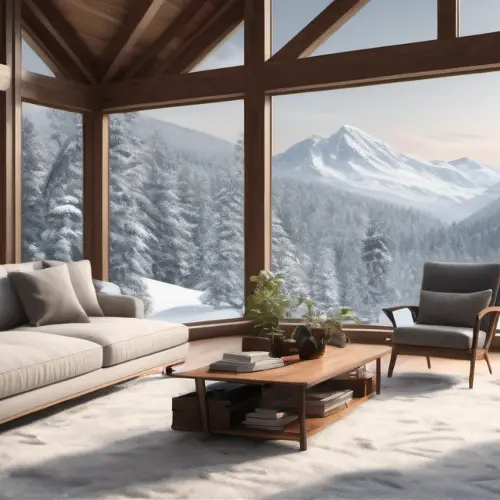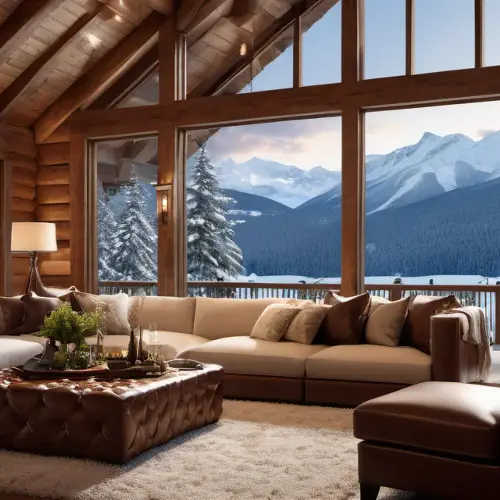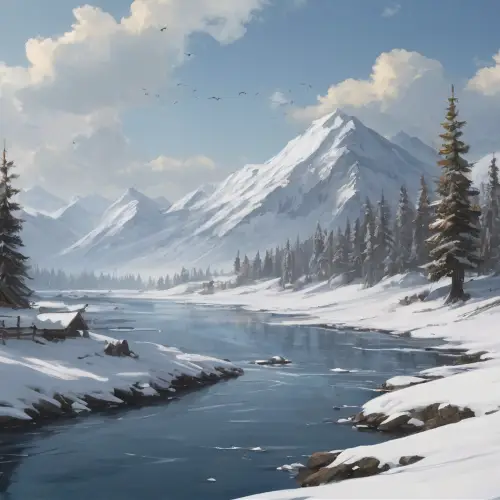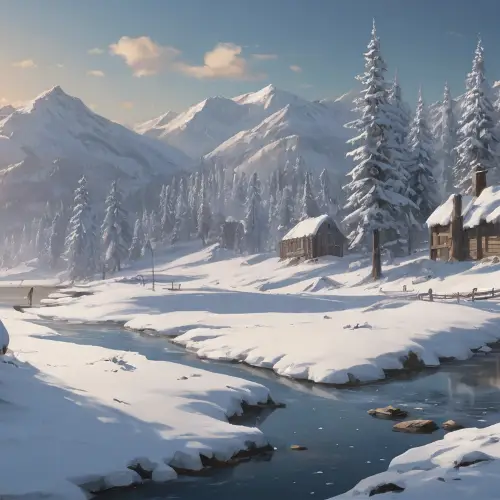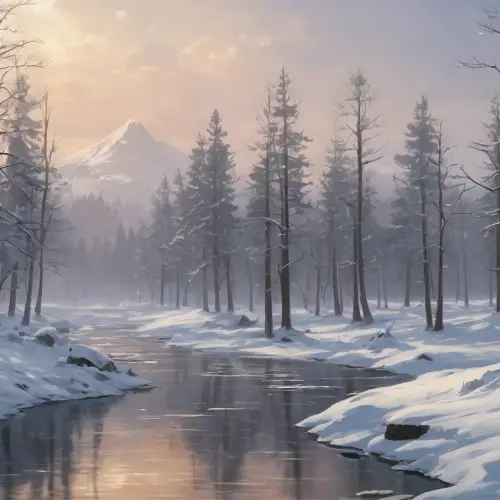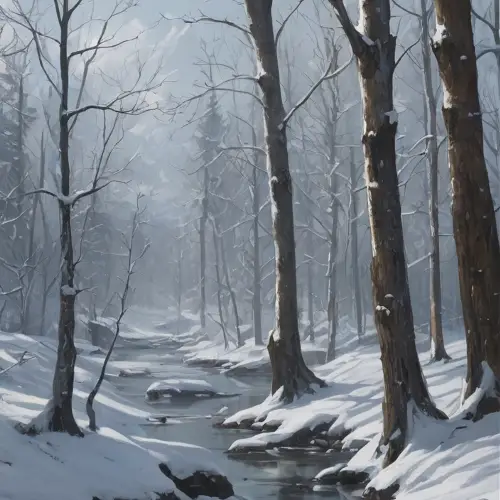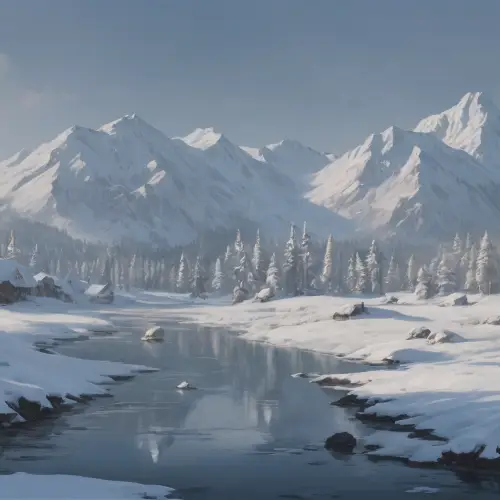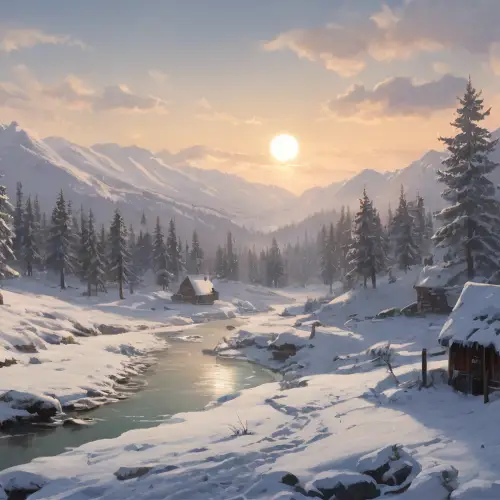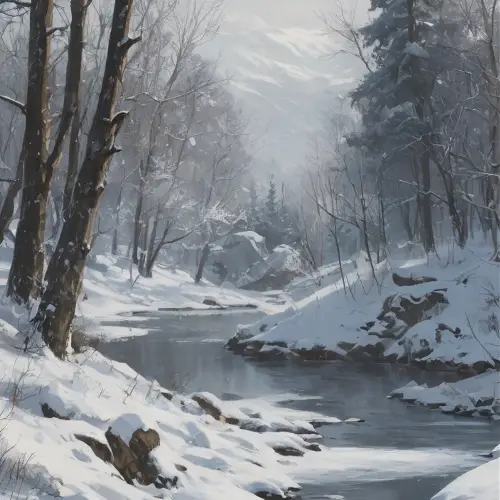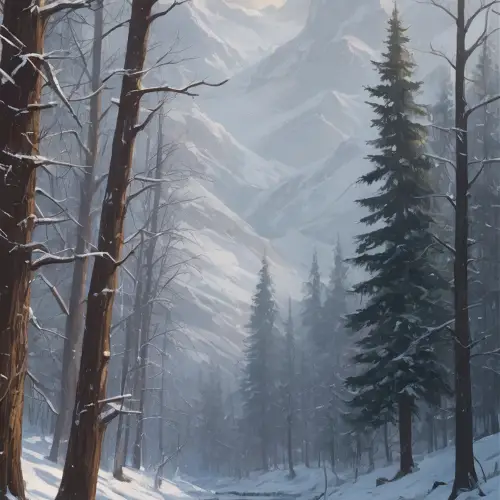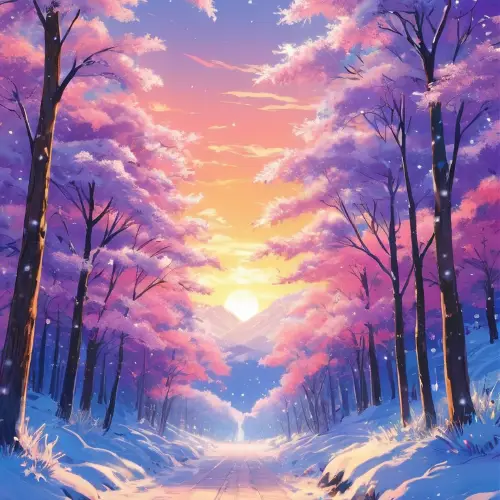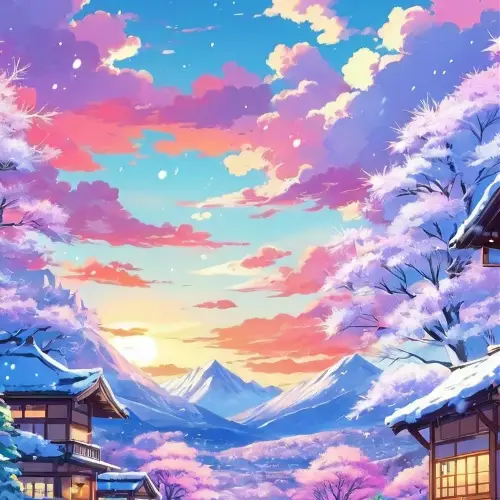To create a visual representation of a \"winter forest,\" we'll consider conveying the essence of a forest during the wintertime. This entails depicting elements such as bare trees, snow, cool color tones, and perhaps wildlife or signs of life that are commonly associated with a forest in the winter season. Here's how you can create this visual representation: Overall Layout: Decide on the perspective of your visual – it could be a landscape view, a close-up of a part of the forest, or an abstract representation. Sketch or outline the basic shapes and areas where you will place the main elements such as trees, snowdrifts, and the sky. Trees: Draw or use images of trees with bare branches to represent deciduous trees in their dormant state. For evergreen trees, indicate their shapes with fuller, triangular forms to contrast with the bare branches. Use white or light gray to add touches of snow on the branches. Snow: Depict snow on the ground with curving lines to represent undulating snowdrifts. Use a bright white or slightly blue-tinted white for the snow to convey chilliness. Consider adding subtle shadows to the snow to create depth, using light blue or gray. Color Palette: Utilize cool tones such as blues, whites, and grays to convey the cold temperature. If there's a sunrise or sunset, you may introduce warmer hues like pink or orange in the sky, but keep it subtle. Wildlife and Details: If you want to showcase life in the winter forest, consider adding animals such as deer, rabbits, or birds. You can also add finer details like animal tracks in the snow, icicles hanging from branches, or a frozen stream. Atmosphere: Create a sense of atmosphere by adding light fog or mist to illustrate cold winter air, using light grey or soft white washes. To depict a time of day, consider the position and color of light; soft morning light, the gray overcast of midday, or the golden hues of a setting sun. Finishing Touches: Review your visual to ensure a balanced composition, and add any final details or adjustments to enhance realism or abstraction, depending on your style. Consider adding a slight vignette effect or framing with tree branches at the edges to draw focus into the center of the scene.
More Like This
To create a visual representation of a \"winter forest,\" we'll consider conveying the essence of a forest during the wintertime. This entails depicting elements such as bare trees, snow, cool color tones, and perhaps wildlife or signs of life that are commonly associated with a forest in the winter season. Here's how you can create this visual representation: Overall Layout: Decide on the perspective of your visual – it could be a landscape view, a close-up of a part of the forest, or an abstract representation. Sketch or outline the basic shapes and areas where you will place the main elements such as trees, snowdrifts, and the sky. Trees: Draw or use images of trees with bare branches to represent deciduous trees in their dormant state. For evergreen trees, indicate their shapes with fuller, triangular forms to contrast with the bare branches. Use white or light gray to add touches of snow on the branches. Snow: Depict snow on the ground with curving lines to represent undulating snowdrifts. Use a bright white or slightly blue-tinted white for the snow to convey chilliness. Consider adding subtle shadows to the snow to create depth, using light blue or gray. Color Palette: Utilize cool tones such as blues, whites, and grays to convey the cold temperature. If there's a sunrise or sunset, you may introduce warmer hues like pink or orange in the sky, but keep it subtle. Wildlife and Details: If you want to showcase life in the winter forest, consider adding animals such as deer, rabbits, or birds. You can also add finer details like animal tracks in the snow, icicles hanging from branches, or a frozen stream. Atmosphere: Create a sense of atmosphere by adding light fog or mist to illustrate cold winter air, using light grey or soft white washes. To depict a time of day, consider the position and color of light; soft morning light, the gray overcast of midday, or the golden hues of a setting sun. Finishing Touches: Review your visual to ensure a balanced composition, and add any final details or adjustments to enhance realism or abstraction, depending on your style. Consider adding a slight vignette effect or framing with tree branches at the edges to draw focus into the center of the scene.
To create a visual representation of a \"winter forest,\" we'll consider conveying the essence of a forest during the wintertime. This entails depicting elements such as bare trees, snow, cool color tones, and perhaps wildlife or signs of life that are commonly associated with a forest in the winter season. Here's how you can create this visual representation: Overall Layout: Decide on the perspective of your visual – it could be a landscape view, a close-up of a part of the forest, or an abstract representation. Sketch or outline the basic shapes and areas where you will place the main elements such as trees, snowdrifts, and the sky. Trees: Draw or use images of trees with bare branches to represent deciduous trees in their dormant state. For evergreen trees, indicate their shapes with fuller, triangular forms to contrast with the bare branches. Use white or light gray to add touches of snow on the branches. Snow: Depict snow on the ground with curving lines to represent undulating snowdrifts. Use a bright white or slightly blue-tinted white for the snow to convey chilliness. Consider adding subtle shadows to the snow to create depth, using light blue or gray. Color Palette: Utilize cool tones such as blues, whites, and grays to convey the cold temperature. If there's a sunrise or sunset, you may introduce warmer hues like pink or orange in the sky, but keep it subtle. Wildlife and Details: If you want to showcase life in the winter forest, consider adding animals such as deer, rabbits, or birds. You can also add finer details like animal tracks in the snow, icicles hanging from branches, or a frozen stream. Atmosphere: Create a sense of atmosphere by adding light fog or mist to illustrate cold winter air, using light grey or soft white washes. To depict a time of day, consider the position and color of light; soft morning light, the gray overcast of midday, or the golden hues of a setting sun. Finishing Touches: Review your visual to ensure a balanced composition, and add any final details or adjustments to enhance realism or abstraction, depending on your style. Consider adding a slight vignette effect or framing with tree branches at the edges to draw focus into the center of the scene.
To create a visual representation of a \"winter forest,\" we'll consider conveying the essence of a forest during the wintertime. This entails depicting elements such as bare trees, snow, cool color tones, and perhaps wildlife or signs of life that are commonly associated with a forest in the winter season. Here's how you can create this visual representation: Overall Layout: Decide on the perspective of your visual – it could be a landscape view, a close-up of a part of the forest, or an abstract representation. Sketch or outline the basic shapes and areas where you will place the main elements such as trees, snowdrifts, and the sky. Trees: Draw or use images of trees with bare branches to represent deciduous trees in their dormant state. For evergreen trees, indicate their shapes with fuller, triangular forms to contrast with the bare branches. Use white or light gray to add touches of snow on the branches. Snow: Depict snow on the ground with curving lines to represent undulating snowdrifts. Use a bright white or slightly blue-tinted white for the snow to convey chilliness. Consider adding subtle shadows to the snow to create depth, using light blue or gray. Color Palette: Utilize cool tones such as blues, whites, and grays to convey the cold temperature. If there's a sunrise or sunset, you may introduce warmer hues like pink or orange in the sky, but keep it subtle. Wildlife and Details: If you want to showcase life in the winter forest, consider adding animals such as deer, rabbits, or birds. You can also add finer details like animal tracks in the snow, icicles hanging from branches, or a frozen stream. Atmosphere: Create a sense of atmosphere by adding light fog or mist to illustrate cold winter air, using light grey or soft white washes. To depict a time of day, consider the position and color of light; soft morning light, the gray overcast of midday, or the golden hues of a setting sun. Finishing Touches: Review your visual to ensure a balanced composition, and add any final details or adjustments to enhance realism or abstraction, depending on your style. Consider adding a slight vignette effect or framing with tree branches at the edges to draw focus into the center of the scene.
To create a visual representation of a \"winter forest,\" we'll consider conveying the essence of a forest during the wintertime. This entails depicting elements such as bare trees, snow, cool color tones, and perhaps wildlife or signs of life that are commonly associated with a forest in the winter season. Here's how you can create this visual representation: Overall Layout: Decide on the perspective of your visual – it could be a landscape view, a close-up of a part of the forest, or an abstract representation. Sketch or outline the basic shapes and areas where you will place the main elements such as trees, snowdrifts, and the sky. Trees: Draw or use images of trees with bare branches to represent deciduous trees in their dormant state. For evergreen trees, indicate their shapes with fuller, triangular forms to contrast with the bare branches. Use white or light gray to add touches of snow on the branches. Snow: Depict snow on the ground with curving lines to represent undulating snowdrifts. Use a bright white or slightly blue-tinted white for the snow to convey chilliness. Consider adding subtle shadows to the snow to create depth, using light blue or gray. Color Palette: Utilize cool tones such as blues, whites, and grays to convey the cold temperature. If there's a sunrise or sunset, you may introduce warmer hues like pink or orange in the sky, but keep it subtle. Wildlife and Details: If you want to showcase life in the winter forest, consider adding animals such as deer, rabbits, or birds. You can also add finer details like animal tracks in the snow, icicles hanging from branches, or a frozen stream. Atmosphere: Create a sense of atmosphere by adding light fog or mist to illustrate cold winter air, using light grey or soft white washes. To depict a time of day, consider the position and color of light; soft morning light, the gray overcast of midday, or the golden hues of a setting sun. Finishing Touches: Review your visual to ensure a balanced composition, and add any final details or adjustments to enhance realism or abstraction, depending on your style. Consider adding a slight vignette effect or framing with tree branches at the edges to draw focus into the center of the scene. To bring this visualization to life, you can use various mediums such as drawing by hand, digital illustration, or even arranging a collage with mixed materials. Consider also the context in which this visual will be used, as that might dictate the level of detail and stylization you apply to your representation of the winter forest.
Generate an ultra-realistic and immersive environment set in a winter forest, featuring dense clusters of snow-covered trees. Convey a surreal atmosphere by incorporating subtle details like glistening ice on branches and a pristine blanket of snow on the forest floor. . The lighting should capture the serene yet haunting ambiance of the scene, and the overall composition should elicit an emotional response, blending realism with a touch of surrealism
Generate an ultra-realistic and immersive environment set in a winter forest, featuring dense clusters of snow-covered trees. Convey a surreal atmosphere by incorporating subtle details like glistening ice on branches and a pristine blanket of snow on the forest floor. Include a partially ruined house far away in the background, half-buried in snow, evoking a sense of abandonment and mystery. The lighting should capture the serene yet haunting ambiance of the scene, and the overall composition should elicit an emotional response, blending realism with a touch of surrealism
Generate an ultra-realistic and immersive 3D environment set in a winter forest, featuring dense clusters of snow-covered trees. Convey a surreal atmosphere by incorporating subtle details like glistening ice on branches and a pristine blanket of snow on the forest floor. Include a partially ruined house in the background, half-buried in snow, evoking a sense of abandonment and mystery. The lighting should capture the serene yet haunting ambiance of the scene, and the overall composition should elicit an emotional response, blending realism with a touch of surrealism
The scenery in winter is stunning, with magnificent snow. It features towering snow-covered trees that add a touch of magic to the scene. Theres also a charming snowman standing proudly in the foreground, creating a whimsical atmosphere. The backdrop includes majestic buildings that complement the serene beauty of the snow-covered surroundings. To ensure that the resulting images are of the highest quality and realism, please include the following tags: (Best Quality, 4k, 8k, High Resolution, Masterpiece: 1.2), Super Detailed, (Realistic, Photorealistic, Photorealistic: 1.37), HDR, Ultra HD, studio lighting, ultra-fine painting, sharp focus, physically based rendering, extreme detail, professional, vibrant colors and bokeh. To enhance the artistic style of your image, consider adding a \Landscape\ tag to emphasize the beautiful winter scenery. In terms of color tone, please use blue, white, and silver as the main colors to create a cool and bright atmosphere. As for lighting, make sure the scene is bathed in soft natural light, with subtle changes in shadows creating a sense of depth and dimension. Remember to maintain a coherent and harmonious composition, Studio Ghibli style, environment painting, EpicSky,
Generate a photo-realistic, high-resolution image of a luxurious living room inside a mountain lodge, nestled in a dense forest. The room should exude warmth and comfort, featuring a large, crackling fireplace as its centerpiece. The walls are adorned with rich, minimalist decor that complements the natural modern interior. Expansive ceiling-to-floor windows provide an unobstructed, panoramic view of the surrounding winter landscape. Outside, the scene is breathtaking with thick, snow-covered trees and gentle snowflakes falling serenely. The lighting inside the room should be warm and inviting, contrasting with the cool, white snow outside. The image should capture the essence of a cozy, opulent retreat in the midst of a serene, snowy forest, providing an immense, almost tangible view of the winter wonderland outside. Emphasize the clarity and detail to make the scene as realistic and inviting as possible, showcasing the perfect harmony of luxury and nature. 50mm lens at f1.4 aperture
Generate a photo-realistic, high-resolution image of a luxurious living room inside a mountain lodge, nestled in a dense forest. The room should exude warmth and comfort, featuring a large, crackling fireplace as its centerpiece. The walls are adorned with rich, minimalist decor that complements the natural modern interior. Expansive ceiling-to-floor windows provide an unobstructed, panoramic view of the surrounding winter landscape. Outside, the scene is breathtaking with thick, snow-covered trees and gentle snowflakes falling serenely. The lighting inside the room should be warm and inviting, contrasting with the cool, white snow outside. The image should capture the essence of a cozy, opulent retreat in the midst of a serene, snowy forest, providing an immense, almost tangible view of the winter wonderland outside. Emphasize the clarity and detail to make the scene as realistic and inviting as possible, showcasing the perfect harmony of luxury and nature. 50mm lens at f1.4 aperture
Generate a photo-realistic, high-resolution image of a luxurious living room inside a mountain lodge, nestled in a dense forest. The room should exude warmth and comfort, featuring a large, crackling fireplace as its centerpiece. The walls are adorned with rich, rustic decor that complements the natural wooden interior. Expansive ceiling-to-floor windows provide an unobstructed, panoramic view of the surrounding winter landscape. Outside, the scene is breathtaking with thick, snow-covered trees and gentle snowflakes falling serenely. The lighting inside the room should be warm and inviting, contrasting with the cool, white snow outside. The image should capture the essence of a cozy, opulent retreat in the midst of a serene, snowy forest, providing an immense, almost tangible view of the winter wonderland outside. Emphasize the clarity and detail to make the scene as realistic and inviting as possible, showcasing the perfect harmony of luxury and nature.
realistic photo, the painting of a winter forest with snow-covered pine trees is a classic oil painting. It depicts a dense forest covered with a thick layer of snow. Pine trees tower above the rest of the vegetation, their branches strewn with white snowflakes. In the distance you can see small farmer's houses, which create a feeling of comfort and warmth.
The painting of a winter forest with snow-covered pine trees is a classic oil painting. It depicts a dense forest covered with a thick layer of snow. Pine trees tower above the rest of the vegetation, their branches strewn with white snowflakes. In the distance you can see small farmer's houses, which create a feeling of comfort and warmth.
Winter landscape, mountains in the background, forest, a lot of snow, sunlight, a path stretching into the distance, trees in the foreground
Winter landscape, mountains in the background, forest, a lot of snow, sunlight, a path stretching into the distance


